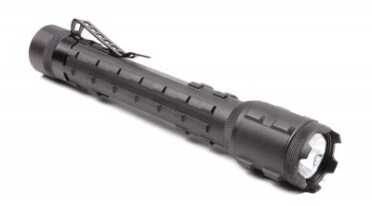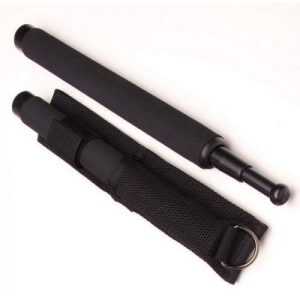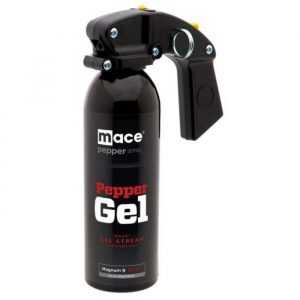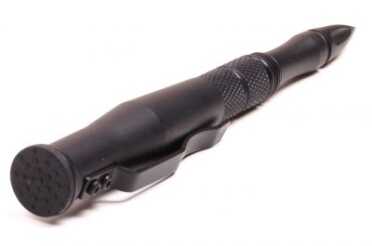Editor’s Note: The following is a post by Mark Kakkuri, a nationally published freelance writer who covers guns and gear, 2nd Amendment issues and the outdoors. His writing and photography have appeared in many firearms-related publications, including the USCCA’s Concealed Carry Magazine. You can follow him on Twitter @markkakkuri.
If you can’t or don’t want to carry a handgun, consider these other defensive tools. We call them “less-lethal” because their use is meant more for escape or deterrence and usually don’t prove fatal to an attacker. Moreover, depending on a variety of circumstances — including your skill in using them — each tool’s effectiveness can vary widely. And each has pros and cons.
1. Tactical Light

A well-built tactical light carries easily and deploys quickly. Use it not only to light up your way but also to blind an attacker, strike an attacker or both.
It should be fairly obvious how useful a regular flashlight would be just in normal, everyday life. Tactical flashlights, even more so. While the term “tactical” gets thrown around a lot and sometimes loses its meaning, I simply mean a flashlight combining the following elements: robust construction (preferably aircraft-grade aluminum), small in size and light in weight, bright light output, and the ability to survive the elements or a fall.
The robust construction gives it its strength as a handheld defensive tool. The small size and light weight make it easily portable so you’ll always have it with you. The bright light is not only to see or to signal someone but also to shine in an attacker’s eyes. And the ability to stand up to hard use or survive a fall means it’s durable and tough — able to be used as an impact weapon if need be. Adding a crenulated bezel helps but isn’t as important as the other features. And it can be any color, not just black.
Pro: A blinding light can keep an attacker far enough away from you to facilitate escape.
Con: To use the flashlight as an impact weapon means your attacker has gotten too close.
2. Electroshock Devoices

The Taser Pulse is a civilian-legal electroshock self-defense weapon that delivers a 30-second knockdown cycle.
“Stun gun” is a popular name for an electroshock self-defense weapon that discharges electricity with the pull of a trigger or push of a button. Hitting an attacker with a jolt from a device like this will cause him to lose muscle control, likely ceasing his attack on you.
Some stun guns create an arc of electricity between two electrodes; these require you to touch an attacker in order to administer the shock. Other “stun guns” fire barbed projectiles attached to wires. These projectiles hit an attacker and physically imbed in the attacker’s skin, usually at a short distance, and the electric shock is delivered through the wires. States have varying laws on the use of electroshock weapons so be sure you research before you buy.
Pro: Properly used, a stun gun is very effective at stopping an attack.
Con: Carrying a stun gun is similar to carrying a regular handgun in that improper use can be very dangerous.
3. Telescoping Baton

A telescoping baton is a simple strike weapon. Hopefully, all you need to do is show it to scare off the threat in a self-defense situation.
Carried by many law enforcement officers, the telescoping baton is a simple strike weapon. Available in lengths from 16 inches to 26 inches (extended or deployed), the telescoping baton can be reduced in length to just several inches and is, therefore, easy to carry.
To deploy it to ward off a threat, you swing the baton in an arc, the force of the swing causing it to expand to its full length. Because these batons are often made of high-strength steel (or, in some cases, lighter aluminum), they are very strong and durable. While some regard their deployment to be a deterrent in an of itself, proper use of a baton requires training.
Pro: Safe and small when carried. Easy deployment.
Con: To employ a baton means your attacker has gotten too close.
4. Pepper Spray

Mace is the leading brands of pepper spray on the market. When it is sprayed into the air it may not only effect your attacker but you as well. Spray with caution and precision!
“Pepper spray” comes in many forms — pellets, sprays, foams, etc. — and might be referred to as “mace” or other names. Generally, we’re referring to an aerosol spray containing chemicals that could temporarily blind an attacker if sprayed in his or her face. Pepper spray might also irritate skin, affect breathing and more.
Pepper spray containers run the gamut of sizes, from finger-sized, single-use devices carried on a keychain to devices that look like and fire similar to a small handgun. Depending on a variety of circumstances, someone who is hit in the face with a blast of pepper spray will find it very difficult to see, breathe and function normally, potentially facilitating your escape. But the deterring effects can take a few seconds to actually work and they’ll only be effective for so long.
Pro: Very small and easy to carry. Allows deployment before an attacker gets too close.
Con: Slow to deploy. Very susceptible to environmental conditions. Some attackers might not be affected by pepper spray as much as others, and some may not seem to be affected by it at all.
5. Tactical Pen

It’s just a pen … with a purpose. In a pocket or in your hand, no one will even notice or care. But it might be an important last-ditch strike weapon to help you escape an attack.
Perhaps the most innocuous of all the less-lethal tools mentioned here, a tactical pen can be a tool designed as such or it might be just a regular pen you use to thwart an attack (as long as it is strong enough). Most tactical pens are black, made from aircraft-grade aluminum and feature a sharp or blunt strike tip. Other than that, they’re just pens. Keep it in your shirt pocket or pants pocket — no one will notice. Carry it in your hand, ready to use; it’s just a pen. With some training, you can use a tactical pen as a kuboton, though the best use of a tactical pen is jotting down incident notes to aid law enforcement.
Pro: A tactical pen hides in plain sight and can go virtually anywhere. (That said, always check with the TSA before attempting to bring any defensive device onto an airplane.)
Con: It’s a small, simple impact weapon with limited use. If you’re using a tactical pen to defend yourself, your attacker has gotten too close.
Conclusion
As with any defensive mindset or tactic, never shirk your situational awareness responsibilities and do everything you can to avoid trouble in the first place. It won’t always be possible, but many times an attacker gets too close because the victim wasn’t paying attention to their surroundings.
Do what you need to do to be prepared and bear in mind that most of these tools’ use is limited to when an attacker is very close to you — usually within arm’s reach. As such, their use comes with a warning: Any tool you use to defend yourself could potentially be used against you. So, if you choose to use any of these tools, get the appropriate training to go with each one.
What are your thoughts on less-lethal defensive tools? Which of these do you carry?
For more critical information on the use of deadly force and other firearms and self-defense topics, visit www.uscca.com/GunsAmerica.

Use your BRAIN! Not just for the situational awareness but what objects are at hand that could be used to fend off a attacker? Anything you can lift with one hand can be thrown. Any salt, pepper, dirt or chemicals bleach, bug spray that can be tossed in attackers face? Aerosol spray cans with flammable contents: light em up! What else can you set on fire and swing? What can be used as a club? Lamps, table legs, chairs?What can be broken to make a stabbing or cutting weapon? Bottles, flower vases, mugs? Got tools? Hammer, heavier wrenches, hammer, screw drivers? What on you? Keys between fingers, pens poke, belts swing and choke, coat arm wrap deflector, fingers fit eye sockets. The only time you don’t have defensive tools is when you let panic shut off your brain.
He’ s talking about stuff to carry. I doubt you would be dragging around a table and bleach.
My first line was “Use your Brain”. Everybody carries one but under stress, fear, panic or shock they don’t use it creatively, they defer to what they know. Its fine to carry LTL tools but they can also be restricted in places you need to go uust like your CCW. Like any problem, when it first surfaces your starting from scratch to solve it. I’m trying to teach people to look at their enviorment differently: right now. As you repetitively recognize objects that can be used as defensive tools, it will speed your response when/if needed.
Common sense Sensei. The brain is our most important weapon.
Sorry to bust scrote but when students or wannabes ask me about LTL carry I ask them why do you want to know?
I say, ‘are you already pro-level proficient to 98% effectiveness in shooting, knife, and serious damage hand-to-hand to be an operator grade CQC fighter to be so bored already and want to venture into other knock-offs? Then I guess it’s okay, I’m a fan of archery, sword fighting, knife throwing, and a few others. But I’m a one punch knock out artist and a two-three strike bury you forever or at least put you in a wheel chair for a long time fighter who also never misses with his carry gun.
So if you’re not trained and practiced as a hand-to-hand fighter, why would you be carrying anything so stupid as a ‘tactical pen’ LOL which is highly limited compared to a tactical folder in the hands of an amateur. or anything else that has a purpose of NON Lethal application…WHEN THE FUCKING ASSAILANT WILL HAVE NO PROBLEMS DOING SERIOUS LETHAL ATTACKS ON YOU? You know, it’s like bringing a knife to a gunfight. Or at least seriously ‘handicapping’ yourself in a game of one on one hoopla with a semi-pro league player?
If you’re worried about needing to defend yourself when out and about your daily business or life’s adventure get some training and carry a gun. Also a knife and learn at least a few basic slash and thrust moves. If you don’t want to or can’t get really proficient with these tools then you must also, as several have echoed herein, make it a habit of Not being an airhead on fart fumes and make sure you always AVOID danger ahead of time by developing your situational awareness skills and habits. And if in doubt, turn about. Don’t take the chance of even being in the possibility of a bad situation.
Carrying stupid shit like LTL toys if you’re Not already highly trained fighter gives you a false sense of security, which of course, will make you an easier target and get you dead.
I always have a table close to hand and a small container of bleach. Never leave home without it…
Yes,and this is why inside I chuckle when I see a stupid no weapon sign on a door I walk thru! The trained aware mind is the most lethal weapon.